One common management question when coaching teams or coaching organizations is: "Yes, but what about network teams?”. “What about temporary project teams, distributed teams and temporary task forces?” Indeed, what are the predictable differences when managing teams or coaching teams:
- Who’s members are predominantly part-time, also engaged in other teams, projects and systems?
- Who’s members are distributed over a large geographical areas?
- Who’s members also report to other managers in a complex matrix-management system?
- Who’s life span is temporary, centered on a time-specific project?
Today, these questions may reveal a nostalgic frame of reference for more traditional well defined local teams. It reminds one that one of the main criteria that has defined team existence in the past is team time-space coherence. This team coherence rested on the principle that if one can regularly get employees in the same location, between say 9:00 am and 5:00 pm, then one can build and manage a team. In the past, the territorial collective play-pen or corral of sorts, was one of the key criteria that held people together, permitted supervision or control, facilitated communication flow and follow up, developed collective identity and permitted solid professional interfacing. In this organizational past, in the same way as for families, tribes and nations, team identity if not team existence has been strongly linked to team territory. Concomitantly with the information revolution, times have radically changed!
To be more precise, even within the few remaining local teams today, it is often necessary to deploy special efforts to meet regularly in a way that is structuring enough for team efficiency. Most modern teams do not exist in a fixed or predictable time-space. Past is the time where a team manager could "oversee" his personnel at a glance, and check them in and out of a limited and well-controlled environment. The same nonlocal criteria is affecting the very concept of coaching teams.
It is more and more impossible to meet regularly if one considers a weekly, or monthly rhythm. All seems to indicate that local teams are becoming the exception, associated with archaic organizations and hierarchies. This extremely interesting development will oblige organizations, or is already obliging organizations and managers to look elsewhere than in territory and direct or regular visual communication or control to define and manage a team.
Beyond practical considerations, this change in team structure raises a number of new organizational questions that can be answered or solved with a systemic team coaching approach:
- What are the systemic criteria a modern team, and for that matter, what makes a modern family, a modern nation, etc. if we exclude time-space unity?
- What is the appropriate systemic leadership and followership frame of reference for participating in modern network teams and systems
- What are the appropriate systemic management values, principles, behaviors, tools, methods, etc. coherent with that frame of reference?
- How can systemic coaching accompany the development of performance within distributed or dispersed systems?
To consult an article on Masterful Systemic Coaching in an individual executive coaching context
To consult an article on general systemic team coaching tools
LOCAL TEAMS
To illustrate some of our thoughts on the subject and proceed with considerations on the role of systemic coaching, consider the following differences between two opposite or complementary types of teams, with illustrations. Traditionally, belonging to a team or any system, meant a certain commitment to well defined time-space. These were local teams.
Punching in and out with time clocks best illustrates the territorial dimension in this type of team concept. It is the equivalent of showing a passport to a border official as you enter a national territory, or a membership card when you enter a private club.
In this frame of reference, when people are absent from their team, for trips, missions and projects, it is for a limited contractual amount of time. Whenever a team member is absent too often or too long, say for more than fifty percent of team time-space, that person would be considered as uncommitted, out of the team, be defined as an exception or again just administratively attached to the team, while working on an independent project.
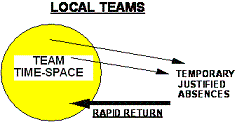
These formal or traditional teams and systems very often use the difference between what is within the boundary compared to what is outside to define their identity. A team member is in, a non-member is out. The team or system has goals that concern all people and resources within. The team or system displays rules and regulations, rights and duties, advantages and disadvantages which are implemented indifferently to all team members, and which do not concern non-members.
We could say that these teams display a "centripetal" energetic polarity in that the difference with the environment has to be clearly defined to justify the existence of a boundary. A form of "us-versus-them" and "not-born-here" segregating behavior against people and ideas from the outside will often be induced by the process. In return, the process permits the development of a strong sense of collective cohesiveness, purpose, identity and sense of security.

This boundary and territory-related team process has been the basis for creating and developing teams for centuries. The approach is obviously similar to family systems in the past, to family and national territorial existence. In as much as survival for these systems was based on material sustenance such as food and other raw materials that came from the land, territorial ownership and identification was the equivalent of existence or life insurance.
DISTRIBUTED TEAMS
What then is the rational for the recent proliferation of non-local teams or "distributed" teams? To give a tentative answer based on different systemic principles, it seems that more and more systems are offering services or managing information. To make a living, these new systems are not dependent on any "locality", but on a communication network. These modern teams are not concerned with "building" anything per se, but with managing the flow of "significant energy" in the form of services and information. Consequently more than identifying with places, it is becoming much more useful to identify with the systemic interfaces that attempt to link those places.
As we plunge more and more into the high-tech and communication-centered twenty-first century, the historical criteria for team existence, work and development, for team identity and organization survival are being questioned and modified. Consequently, a simple graphic form of a new-age team system could look like the following.
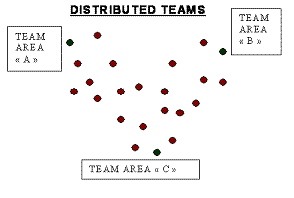
In this type of organization that rests on different systemic principles, which could be spread out over a continent, few people formally or geographically "belong" to only one team. Some people are focused on projects which can be considered team-work "areas", but these are rarely full-time places. In our illustration, these "team areas" are arbitrarily placed close to project leaders but that is just a way to position the team in terms of communication links, for convenience's sake. The team could actually never physically meet anywhere close to the physical office of this “communication center”, if, as is often the case, elsewhere or nowhere is more convenient.
In this type of distributed system, most of the people in the organization belong to several teams or participate in several projects. These are usually circumscribed in a larger systemic time frame rather than a physical location, and therefore do not justify heavy administrative structural investment.
The systemic "picture" of "whom belongs where" may well change daily as projects are started, as they grow and then fade away, as resources are re-allocated, as people develop new realms of interest, and as the organization adapts to a more and more rapidly changing environment.
Compared to the first depiction of "local teams", these reactive and opportunist "distributed teams" are much more centrifugal, in that most happens outside of what could be considered a precise team environment or territory. As a matter of fact, most of the time, team territory doesn't formally exist, in a continuous systemic time nor space. Most of their working time, distributed team members are either solitary, or working with other systems in temporary non-local environments.
As a result of this distance and discontinuity, these other significant environments can often have a much stronger daily influence on individual perception, priorities, identity and commitment than the non-local distributed team network could ever have. When and if team members happen to meet in their temporary distributed team environment, it is usually for a short, task-centered marathon, often rendered difficult by travel and jet-lag, considering the long distances often involved.
In some organizations, conference calls and overwhelmingly overloaded mail communication systems have helped keep stronger information links, to a degree. Again, too often, this systemic information is often centered on task.
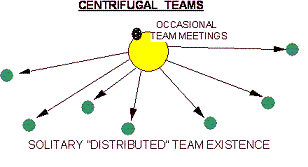
This is where trouble often starts in terms of developing a strong systemic and specific distributed team identity. Identity in organizations, as we have seem above, has so far has been developed through centripetal systemic processes. It often seems impossible for centrifugal systems such as distributed teams to develop a perceptible form of team identity that has the same systemic motivational strength as the more traditional territorial local teams. If so, how then can it be done?
Of course, the million dollar question has not yet been completely answered, at least not in a simple way. This is probably because as usual, the problem has to be approached by opening our minds to new systemic ways of thinking. To continue with our usual metaphorical approach within other fields, however, we now propose a quick look into recent systemic developments and experimentation in quantum mechanics. This field may help us to come up with some inspiration that could apply to distributed team management and systemic coaching.
ELEMENTARY PARTICLES
For centuries, research has very slowly moved forward in a continuous scientific quest to determine the basic building blocks of the known universe. Unfortunately each time we have discovered fundamental or "elementary" building blocks, we have persistently discovered that they were made up of something smaller that seemed to escape definition. This is still the case today. To illustrate the impossibility of defining our limits, the same systemic quest seems to be just as illusive in the opposite direction, when science looks to understand and define what is beyond the last known universe in our larger systemic or intergalactic perception.
This fundamental research, however has permitted physicists to discover what that they were not necessarily looking for. These discoveries are slowly changing our frames of reference, our lives, and maybe our systemic perception of organizational reality.
One of these discoveries, for instance is that "time" and "space" which we perceive as apparently very different realms, can be perceived as two opposite ends of the same continuous systemic spectrum, much as different types of light from infra-red to ultra-violet. This is as real as energy and matter being of the same fundamental realm, as Einstein (E=mc2) and atomic bombs have proved to be true. As a result, for example, the faster we communicate, the smaller the world is becoming. Organizations that use any high-technology information management (speed) are almost necessarily multinational (space).
To build our case for distributed team dynamics, one of the most interesting mind-blowing recent developments in physics, or more particularly in quantum mechanics, is the Bell theorem (originally in 1964) coupled with the Aspect experiment1 (in 1982). The two present a different systemic hypothesis and a form of proof which both provide new insights as to what the real world may be like. More practically for our metaphorical systemic purposes, this theory and proof can help change what will become our perception of organizational systems in the future.
To simply describe the questions raised by Bell and the procedure experimentally proved by Aspect, imagine the following situation and contraption:
A light-creating source which emits pairs of protons, simultaneously creates and sends off two protons or elementary light particles in opposite directions. Except for their opposite direction of travel at the speed of light, these photons are identical twins in that they are both polarized at complementary angles (or have what could be called complementary “spins”), say in this case, horizontal and vertical.

At an equal distance from the photon-emitting light source, measuring devices are installed that permit several maneuvers. For one, it is possible to measure that the polarity of the two photons were still one and the same, after their traveling spree. The photons are measured to have kept their common "twin" polarization, at a distance.
The surprise comes when at the measuring device on one end (A, below), the polarity or spin of one of the photons is modified from its original horizontal nature, in our case, to a vertical one. At the other end, the other measuring device records a simultaneous change in the polarization or spin of the other photon, as if it were still connected to its twin, instantly reacting to mirror its change.
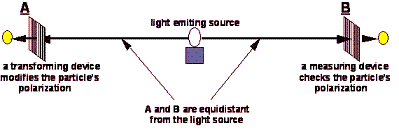
This experiment and the theory that accompanies it raises some important systemic scientific and philosophical questions. First, it seems to prove that "instantaneous" communication at a distance, at twice the speed of light is possible. Until this theorem, and more practically, until the Aspect experiment to demonstrate its validity, anything traveling at a speed exceeding the speed of light had been considered impossible nonsense.
This "simultaneous" communication across space-like2 distances does not happen between just any pair of particles. This happens between two entities that are "twins" in that they have what is considered a common past or origin. They are systemically "initially correlated". To quote Gary Zukav on this link: "When 'separate parts' interact with each other, they (their wave functions) become correlated through the exchange of conventional signals (forces). Unless this correlation is disrupted by other external forces, the wave functions representing these "separate parts" remain correlated forever."3
Now, considering that the whole universe can be defined as "initially correlated" by its unique origin, the Big-Bang, (the equivalent of the twin-producing light source, on a much larger scale) the systemic philosophical question that we can immediately raise concerns the fact that the whole universe could therefore be highly correlated and therefore continuously in instantaneous communication. Nothing can happen anywhere in the universe without creating a simultaneous "correlated" systemic equivalent action somewhere else on the other end. This action would in turn create another simultaneous correlated action elsewhere, ... etc.
UN-CORRELATED AND DISPERSED TEAMS
Now that we have taken a nourishing science fiction trip in the real of infinities, let us get back to our day to day organizations and systems and see how and where the Bell theorem can inspire us. The metaphorical framework above can suggest that keeping a team together or team members "correlated" at a distance may be possible if one proceeds in the correct systemic fashion. Team coherence may indeed have little to do with "locality" or "non-locality" if the right kind of systemic energy is put into initially "correlating" the team elements represented by its members.
What we may need is the equivalent of a strongly "correlating" or systemic energetic integration and "kick-off" (pre-Big Bang) if one expects distributed team members to keep functioning as a coherent systemic whole at a distance. Not "correlating" the team members in the creation period is the best way to create a truly "dispersed" team of independent or chaotic wandering photons that have no common polarization or systemic coherence.
One of the main criteria about most of the inefficient "distributed" teams with which we have had the pleasure of working is that they were never really initially created in the systemic "correlating" sense of the word. We have noticed that their creation act was rarely more than a laconic announcement such as an electronic mail that gives a "by the way..." informative message:
--"Please note that as of this date, Ms. X is the project leader for the Omega team which will include members A, B, C, and D.
Following this non-creation, the dispersed group usually makes some effort at trying to work together, without ever having really been "correlated" in a truly systemic fashion. Some or all of the team members will occasionally meet, most probably to focus on urgency-related partial tasks, generally in a stressed-out atmosphere. Simply coordinating takes so much attention that these team members rarely have the leisure to develop a clear sense of common vision, goal and systemic strategy. Obviously, with these initial conditions, team identity, and most important, systemic team commitment in the correlative or communication-efficient sense illustrated by the Bell theorem will not take form.
Sometimes, later in the non-team’s life, a big enough crisis will luckily come up and force the team or its leadership to take exceptional steps to do what should have been done at the outset. The crisis will create a systemic correlating event which will help correlate the system in the face of extraordinary odds. A little too late.
To share an example illustrated by a case study, we would like to suggest the following process-oriented systemic way to create correlated distributed teams.
DISTRIBUTED TEAM RHYTHM
A client we will call CLUBSERVICE is a world-wide leisure corporation. A few years ago, its operational executive committee focused on the difficult and paradoxical problem of its own distributed team efficiency, and came up with a very specific systemic solution4 .
The world-wide organization needed strong local direction in each of its regions and strong centralized global strategy and systemic coherence. Corporate executives were therefore faced with an apparently impossible dilemma. Either they stayed, lived and managed their regional operations from their headquarters based in a European capital, or they operated from local distributed positions, closer to their regional concerns.
Considering the traveling distances sometimes involving up to eleven jet-lag hours, they could hardly consider traveling constantly and doing both. For awhile, some managers had chosen one option, residing close to headquarters, while the rest chose to privilege living their local regions. Those differing individual choices created quite a systemic disparity in the way the global system was run. This was rapidly considered a poor option.
They decided to solve the disparity by all implementing only one of the options. Now which should they choose?
If all the executives based their operations in headquarters, the corporation would benefit from a strong central identity, clear strategy definition, better information flow between the executives, well informed central decisions, excellent global product coherence, etc... The executive team would then be strong. Unfortunately this would happen at the expense of needed presence in the local systems, and would affect their “distributed” systemic effectiveness.
If the second more distributed team option was chosen, they knew they would loose a lot of points in global market product and strategic systemic coherence as well as all of the other above advantages. On the other hand, it was clear that the local operations would be much stronger, more reactive, more efficient, and that they would get better local operating results.
To attempt to solve the systemic dilemma, the CLUBSERVICE executive team decided on a collective yearly rhythm that would alternate between local and global presence on the following long-rhythm basis: five months-local, one month-global, five months-local, twenty days-global.
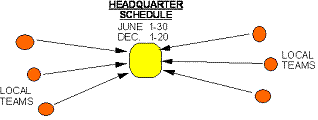
The dates were chosen in keeping with yearly professional cycles and in a way to arrange for vacations and other personal-life arrangements, so as to limit costly and time consuming global to-and-from trips. The rest of the time, the headquarters offices were literally empty of the operational executives who became full time “locals” in their respective distributed regions.
The team spent some time to define their centralized periods so as to ensure the systemic development a strong sense of team purpose on the global level. The first week out of the four set aside in June was allocated to intensive systemic "team coaching and development" sessions accompanied by an external coaching organization. The objective there was to kick off the central organization's work with a very committing and efficient problem-definition and solving approach. That week was there for everyone to touch base with the others, develop team identity and to prepare for the intensive work for the following three weeks. In our mind, it was a good example of excellent systemic "correlation" work both on an interpersonal and collective level.
The third week in December also had a strong focus on organizational correlation energy. During that week, however, the executive team gathered the top 60 managers from the organization world-wide, each time in a different regional location. This was to implement larger organizational systemic coaching processes to develop top executive global awareness and to create a correlating "happening" which could include a more important cross-section of the system.
Some of the elements presented in the above example illustrate some useful systemic concepts in distributed team correlation. One is that it is interesting to develop a regular and predictable systemic rhythm.
If a team meets only once or twice a year, this meeting needs to be a well prepared and highly significant event for all participating members. The activities during those events need to be carefully chosen. These gatherings should not be the place to catch up with very technical business as usual items which could be dealt with through habitual electronic and mail systems, and which are kept on hold just to fill the meeting. Yearly team events should not be the place within which all the team members will cram their full-year's agenda in the most intensive and stressful possible way.
Much the contrary, from our growing systemic experience in the field, we have often concluded that significant gatherings should be as open or emergent as possible to promote systemic creativity, thought and reflection, questioning and discussion. They need to be in keeping with the spirit of what is called a learning organization, and could accompanied by an open systemic coaching approach which can allow for emerging realities. These meetings can gain in being structured in such a way as to accept surprises and provoke system creativity. They also really serve their systemic purpose when they permit learning, research, personal involvement and sharing, and heart-warming celebration.
In other words, what makes for an excellent systemic correlation of the type needed by distributed teams, especially when their meetings or reunions are scarce, is a bond-strengthening and nourishing gathering rather than an intensive task-oriented workaholic marathon.
Following successful systemic correlating of meetings, when individual team members returns to their local or distributed regions or areas, each seems to carry back an energetic form or print of the entire team's reality or systemic identity. This form is much more related to the process or the spirit of the collective time than to its contents per se. It is related to the way and things were lived or shared, to the intensity of the systemic energy that was exchanged in the process, and sometimes to completely incidental or accidental but very moving or intense moments created by unpredictable events.
Another important factor we have regularly observed in strong correlating events is that they are authentically related to the team's real development concerns and long term systemic vision. In other words, an incentive trip or a light show or a sporting event are not important or useful correlating means as such. What is necessary to ensure their systemic correlating success is that these must just be means or support systems to develop the team's awareness, identity, or authentic transparence to itself in both its positive and negative dimensions. Successful systemic correlating is therefore achieved by developing opportunities for authentic team-awareness centered on regularly redefining clear organizational vision.
Although it is not the intent of this article to extensively develop the importance of organizational vision, there are a few very counter productive traps to avoid if one were to want to develop systemic team or organizational “correlating”.
Primarily, organizations must take care not to fall into the usual verbal traps that management often fail to avoid. A statement on a vision is not a vision. So a “correlating” organizational vision is not a series of motivational statements focused on an idealized future and lofty developmental goals, distributed top-down though H.R.-marketed posters and manuals. In all too many organizations, it seems that the more these idealized statements are posted, the more employees scoff at their management that so obviously display behavior illustrating that they play by other rules.
Ideally, a successful systemic organizational vision and culture is fully integrated in everyday behavior and operations. It is a vehicle for real day to day relational and operating procedures, actively perceived by the personnel, and exemplified by managerial and executive behavior.
If this “real” systemic vision were to be thoroughly formulated, which it is often not, it would include items that would range from definitions of the company culture, items on honesty, fairness and other positive business ethics in the way employees, business partners and clients are treated, and precise definitions of quality in product and service standards. Very paradoxically, it often seems that the environment of an organization, its market and business partners, are the ones most capable of defining the specific qualities of a successful organization’s active culture and vision. They are less prone to taking words for reality.
And as we all intimately know, all seems to indicate that this turn of the century is an ideal historical period for operating significant change in systemic organizational focus and structure.
© Metasysteme-coachin.eu Alain Cardon June 2000, revisited October 2007
1 For the reader interested in a layman's introduction into modern physics, read ZUKAV, Gary, The Dancing Wu Li Masters, Bantam Books, 19802 Like those found in "outer space".
3 ZUKAV, Gary, The Dancing Wu Li Masters, Bantam Books, 1980 p. 2964 This is where we would like to stress that every corporation, trade, team, and organisation has to find its own specific solution to problems that in every case are very different.



